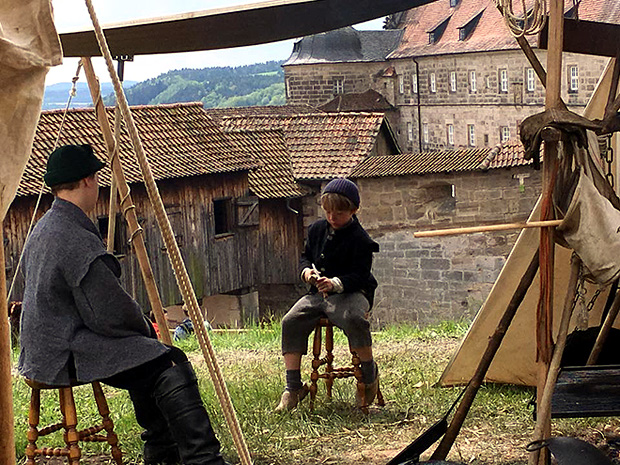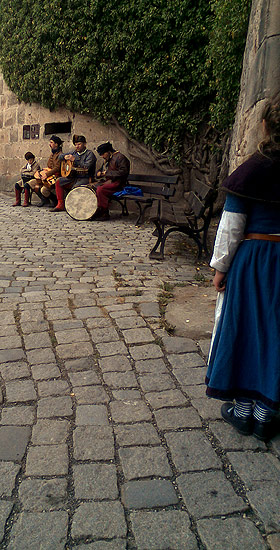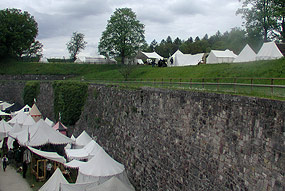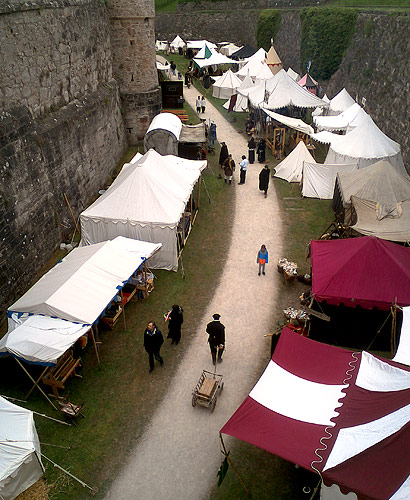

 I
had seen several postings in Facebook of re-enactments in Germany of the
Thirty Years War. I’d wistfully dreamed wouldn’t it be great to go to one of
these. Then, a Bavarian friend, Jürgen Jakob, invited me to one; I
considered it was out of the way, not in my planning, hmmmm – but within so
few seconds, the light went on: “Yeh! I am going!” I
had seen several postings in Facebook of re-enactments in Germany of the
Thirty Years War. I’d wistfully dreamed wouldn’t it be great to go to one of
these. Then, a Bavarian friend, Jürgen Jakob, invited me to one; I
considered it was out of the way, not in my planning, hmmmm – but within so
few seconds, the light went on: “Yeh! I am going!”The biannual event was Crana Historica V, Festival Der Geschichte (History), to be held right outside Kronach, Bavaria, at Festung Rosenberg, 14 – 16 May, the Pfingsten (Whitsun) holiday. The venue was a fortress/castle, Festung Rosenberg, that was built out over centuries. The first building, a tower, is near 1,000 years old. The fortress’s latest additions were during the Napoleonic period. Over the centuries, the fortifications expanded in response to changing military needs and technology; deep stone walls constructed with dry moats in between, bastions added with cannon ports, then more… Access to the outer defenses was by a warren of tunnels. Napoleon himself came to the fortress (Bavaria had allied itself with France) and ordered the great central tower have its onion dome removed to be replaced with an artillery platform. Going from one place to another in the fortress was a walk of over, under, around, and through – the structure was built for defense, not convenience. By good fortune, the fortress was not even nicked during WWII.  Although most re-enactors participating were kitted and armed for the Thirty
Years War, other re-enactors were there for the late Middle Ages, the 18th
Century (including reconstruction of the militia then posted at the
fortress) up to the Napoleonic period, represented by a Prussian artillery
unit. Near all participants were German, but for the Thirty Years War, a few
Italians appeared plus a Hungarian Regiment (the same Hungarians who were at
Slag om Grolle) – oh, and one American.
Although most re-enactors participating were kitted and armed for the Thirty
Years War, other re-enactors were there for the late Middle Ages, the 18th
Century (including reconstruction of the militia then posted at the
fortress) up to the Napoleonic period, represented by a Prussian artillery
unit. Near all participants were German, but for the Thirty Years War, a few
Italians appeared plus a Hungarian Regiment (the same Hungarians who were at
Slag om Grolle) – oh, and one American.Much of the time when the event was open to the public, period musicians were there to entertain. The Hungarians offered their own for Hungarian music of the age (which I confess I enjoy mightily). The camps were set up as Living History, with vendors and craft displays along some well-traveled courses. Although at the end of a set of camps, our own camp had many visitors. We participated in two exercises each day: in the late morning a display of pike prowess and discipline, and late in the afternoon a brief battle before an appreciative audience. Battles were held inside one of the dry moats, with tall stone walls on either side. At the end of one little battle, a feature was added that was rather Thirty Years War: an officer and a soldier went around “euthanizing” the enemy wounded. Evenings were a delight around the regiment’s table. Food was savory and plentiful. Plentiful also was the beer: four barrels of Kaiserhöfer, a local brew quite delicious. Although the language in camp was German, several in the regiment who knew English kindly engaged me in conversation. Best of all, before this event I was self-conscious about speaking any German I knew; they relaxed my inhibition to the point I was using freely what German I could. Hungarian musicians performing near the main gate. |
|
Imperial pike awaiting deployment, then exhibiting their skills before an audience kitted out for the early 21st century. Back to main menu for Reliving History © 2016, Barry L. Siler |

 Living History camps and exhibits were placed within the innermost dry moat plus on top. |